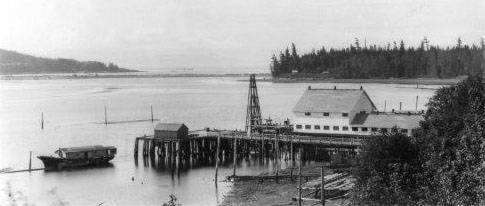Elida Peers | Contributed
Fishing is such a big thing in our region – it’s strange to look back on this photo of the wharves at the foot of Maple Avenue and realize there are almost no vessels in view.
Hardly anyone around has spent more time on the water than Ray Vowles. He was about 12 years old when this photo was taken in the mid-1940s. At that time, he and his siblings had their own little 10-foot putter boats that they ran to help in the seafood harvesting business operated by their parents, Bill and Sarah Vowles.
Few independent commercial fishermen were active here at that time as the salmon industry was dominated by Sooke Harbour Fishing & Packing Company, in its operation of the fishtraps.
During the 1940s, two men who became prominent in fishing were Louis Heggelund and Jack Homer Their boats would not have been moored here, as they each owned waterfront land with their own moorage further to the east.
A piledriver owned by Sooke Harbour Fishing & Packing can be noted, though none of their packers appear in sight. The company’s cannery building is the white structure in the foreground. Its cannery operations had ceased at that time; the fishtraps catch was transported by packer to Esquimalt for processing. We’ve heard that the “live-aboard” pictured at far left was gone by the mid-1940s.
It was after the close of the Second World War that the returning servicemen bought independent fish boats and joined with their Sooke buddies in beginning to make great inroads into the Pacific salmon industry – 1958 was the last year that the fishtraps industry was in operation. By that time the property at the foot of Maple Avenue was owned by Canadian Fish and BC Packers; other changes lay ahead.
By the 1960s and 1970s, this view would have looked very different with fingers extending to the left of the wharf shown, accommodating dozens of trollers, gillnetters and seiners, and with Pallister’s emporium alongside.
Changing decades have brought new scenes to the waterfront. Sports fishermen and charter boat operators, along with whale watchers, now dominate the view. To the right of these wharves, today you would see dozens of sleek vessels, aluminum, fibreglass and wooden, at various moorages along the harbour frontage. Today while many vessels are found at the busy fingers extended to the left, only a few are commercial fishboats.
•••
Elida Peers is the historian of the Sooke Region Museum. Email historian@sookeregionmuseum.com.
editor@sookenewsmirror.com
Like us on Facebook and follow us on Twitter
